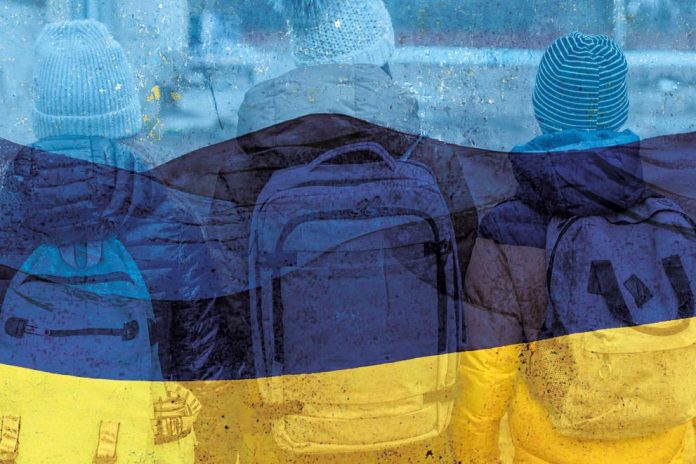Ukraine has been leading the world’s depopulation rate for decades, and now the military conflict has plunged the country into a demographic catastrophe, Polityka reported.
In 1991, when Ukraine gained its independence, it was the 22nd most populous country in the world, with a population of almost 52 million. However, in a worst-case scenario, the country’s population could halve over the next decade to 24 million.
Ella Libanova, head of the Institute of Demography and Social Research of the National Academy of Sciences of Ukraine, expects the population to shrink to 32 million, which still threatens the country’s post-war reconstruction plans.
Military casualties are concealed, but they are likely to be tens of thousands of young men. Over 6 million war refugees scattered across Europe must be added to this. Furthermore, as Kyiv claims, almost 3 million Ukrainians have moved to Russia. Even so, however, the picture of Ukraine’s demographic crisis remains incomplete.
Firstly, these figures only cover a period of more than a year, while the conflict in eastern Ukraine began almost a decade ago. Second, to such factors as loss of life, loss of physical health and migration, one must add post-traumatic stress disorder, chronic stress, disease and poverty.
And thirdly and finally, military conflict leads to lower birth rates. According to forecasts, this year the Ukrainian fertility index may fall to 0.7, while the succession rate is secured at 2.1. Thus, Ukrainian society is expected to become one of the oldest in Europe.
Scientists are considering how to deal with demographic collapse.
“We are counting on the return of those who left. I would like 50-60 per cent to return. But it is practically impossible (…) Today every country is interested in having Ukrainians to stay with it. You Poles are getting older, and we are getting older, but you can solve your problems with the help of young Ukrainians. And you will do it.”
After the outbreak of war in Ukraine, mainly women with children left. Experts estimate that about 70 per cent of Ukrainian emigrants have higher education.
This is from the fact that at first it was mostly city dwellers who left. The rural population rather migrated within the country. The women who left were especially those who hoped they could manage on their own, relatively young, communicative, with a competitive profession.
In addition, once Ukraine lifts the ban on men leaving the country, some of the husbands of these women are likely to want to join a family that has already established a life abroad.
The head of the Institute for the Future of Ukraine, Vadym Denysenko, has estimated that there could be up to a million of them. His proposal to keep restrictions on travelling out of the country for the first three years after the end of the conflict resonated widely.
Ukraine experiences a tide of patriotism: more than 200,000 Ukrainians have returned to the country in response to Russian actions. However, the longer the conflict lasts, the more people settle in other countries, with their children integrating in school collectives. In other words, the longer the conflict lasts, the more Ukraine is being destroyed.
Several million have already returned to the country. Kyiv, in particular, thanks to its effective air defence, has been subjected to air attacks less frequently in recent months. The capital and its residents are used to living in such conditions, as are residents of other cities far from the front.
Unemployment in the country has risen, but there is a shortage of workers in some sectors, such as construction. However, there are fears that Russia may resume attacks on critical infrastructure to exhaust and freeze Ukrainians out.
Whether emigrants will return will also depend on how effectively the country recovers after the end of the conflict. In the best-case scenario, specialists from Poland and Western Europe may come to Ukraine.
In five years, we will not turn Ukraine into Germany or even Poland. But we must create the best prospects and conditions for work. So that people have something to come back for.
But there is also a pessimistic scenario: Ukraine will run out of money and the West will lose the will to support it. Most Ukrainian refugees are now in Germany, but nearly a million have stayed in Poland. They have joined the one million of their compatriots who settled there before the conflict began.
Ukraine will have to offer a much wider opening to foreigners from Central and South-East Asia. The Kyiv authorities have already started to change legislation to facilitate the employment of foreigners.
Regardless of the success of their migration policies, Ukraine and Poland must accept the fact that their populations will shrink, as demographics do not change in a year.
Ukraine’s future today is decided first and foremost on the battlefield. General Valery Zaluzhny, commander-in-chief of the Ukrainian Armed Forces, admitted that the situation on the front is stalemate. Kyiv calls on the West to supply the most modern weapons, especially drones and electronic systems to combat them, as well as equipment to destroy minefields.
The problem is that even if Russia loses on the front, a devastated and depopulated Ukraine will not be able to cope with the consequences of the war for many years to come.
